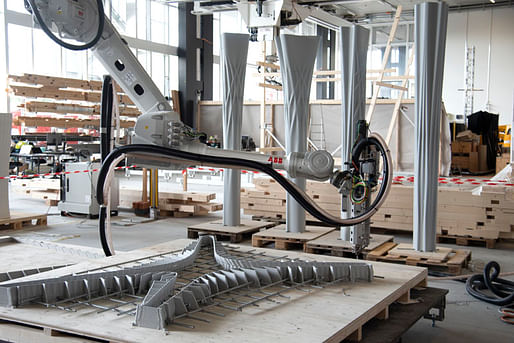
A group of faculty and students from ETH Zurich has completed a prototype architectural pavilion whose production merges 3D printing with computational design. Unveiled at the Vitra Design Museum in Germany, the Eggshell Pavilion’s development seeks to demonstrate how "digital design techniques and robotic 3D printing can enable the creation of freeform concrete structures out of recycled ultra-thin formwork."

The pavilion’s design and fabrication was driven by design algorithms that generated both the geometry of the structure and the fabrication data needed to 3D print the pavilion. The team believes that this combination of computational design and robotic fabrication can unlock the potential for designers to shape concrete elements efficiently, avoiding traditional labor-and-cost-intensive formwork processes.

The 3D printed formwork of the Eggshell Pavilion measures only three to five millimeters thick (or 0.1 to 0.2 of an inch). Made from glass fiber-reinforced PET-G partially recycled from previous Eggshell formworks, the shell is strengthened with conventional steel reinforcement that can be dismantled for reassembly through its use of reversible connections. The pavilion’s four columns were each printed in six hours, while the four-floor slabs each took sixteen hours to print.

With the formwork printed, the pavilion was cast in two different types of concrete. The columns were cast from fast-setting concrete using a digitally controlled casting process chosen to minimize pressure on the formwork. The floor slabs, meanwhile, were cast from conventional self-compacting concrete due to the relatively less pressure exerted on the formwork. Once the concrete was fully set, the 3D printed formwork was removed, washed, shredded, and readied for reuse in future 3D prints.
"[The pavilion’s] construction emphasizes the design possibilities offered by 3D printed formwork combined with conventional reinforcement and assembly methods," the team says. "It demonstrates how the Eggshell technology can be used as an industrially scalable system for material-efficient concrete structures, paving the way towards a more sustainable use of concrete in construction."

The project was designed and fabricated by architectural researchers studying with Gramazio Kohler at ETH Zurich, led by Joris Burger, Petrus Aejmelaeus-Lindström, Guillaume Jami, Marc Akermann, and Theo Bürgin. The project was supported by students of the MAS course in Architecture and Digital Fabrication at the university.

News of the scheme comes months after a separate team at ETH Zurich unveiled FoamWork, a project exploring how foam 3D printing can assist in creating concrete formworks. Other live student projects recently featured in our editorial include a team at IAAC who 3D printed a zero-waste housing prototype using local earth and a series of tiny homes to fight homelessness produced by students of the University of Buffalo, Drury University, and Rice University.
No Comments
Block this user
Are you sure you want to block this user and hide all related comments throughout the site?
Archinect
This is your first comment on Archinect. Your comment will be visible once approved.